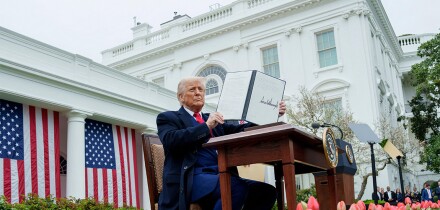In the past few months, equity volatility trading has seen an unprecedented level of interest from investors who have traditionally traded equities, bonds, currencies and other common asset classes.
One key catalyst for this activity is the introduction of volatility indices such as the VSTOXX index, which is a simple standardized metric for the expected volatility of the Dow Jones Euro STOXX 50 index.

Volatility indices are not new. In the U.S., investors have been able to observe the VIX index, a measure of Standard & Poor's 500 volatility, since 1993. Active trading of the index is a more recent phenomenon, although there was trading well before VIX futures launched in 2004. The latest volatility index futures were launched in April 2005 on the Chicago Board Options Exchange's Dow Jones Industrial Average Volatility Index. Similarly in Europe the old VDAX and old VSMI indexes have existed for some time, while the VSTOXX, VDAX-NEW and VSMI indices were launched in April 2005 to meet investor demand for tradeable and liquid European volatility indices. These new indices use an updated methodology which was developed jointly by Deutsche Börse and Goldman Sachs. Investment houses have found it much easier to provide products on these new indices and, as a result, trading has surged, with investors very active in a wide range of innovative new products.
Volatility indices are a good indicator of future risk as implied by the options market. They are based on the prices of options, which are very sensitive to expectations of future volatility. This is of obvious interest to equity market participants who use the information to time their investments and judge risk. There are many more applications, however. For example, some investors seek to take advantage of the unique characteristics of volatility. Volatility has typically been inversely correlated to equity market returns and many equity investors see it as a good hedging vehicle, especially if it can be bought at very low levels. In addition, volatility tends to increase when there is greater uncertainty or nervousness in the market, sometimes without any clear accompanying reaction in the underlying equity market.
Why Trade Volatility?
Fixed-income investors are drawn by the relationship between volatility and credit spreads so, for example, a hedger with credit exposure can either buy volatility or buy credit protection, whichever appears cheaper. Volatility is also related to the correlation between stocks, and since active managers typically find it more difficult to outperform in a high correlation environment, they can buy volatility to hedge against this outcome. Volatility has typically over-reacted in market crises so some see it as a good hedge for so-called crash risk. Some long-short hedge funds have found their profits have been affected by high volatility, or they have risk exposures which do not match more common assets, and so have sought to buy volatility as a hedge.

Volatility has mean-reverting characteristics and it trades in a range for extended periods of time. Most investors accept it has a lower bound not far from current low levels. Volatility cannot fall below zero, but it has no upper bound, so it certainly has an asymmetric distribution. For example, the VSTOXX remained in a range between 20% and 30% for most of the period from 1999 to 2001, while over the past year it has not been higher than 20%, according to data from Goldman Sachs. Using these characteristics some investors have built systematic volatility strategies, while others are more opportunistic, for example, they seek to buy volatility when it is very low, and wait for spikes to sell.
Volatility is a key input in the asset allocation process for many institutional investors and some investors treat volatility as an asset class in itself. They see diversification benefits in including this new asset class in their balanced portfolios. Whether this derivative instrument can be termed a new asset class is largely academic; investors see potential profits, and trading volatility allows portfolio risk characteristics to be customized in a way which was not possible before.
Index Methodology
The methodology used for the VSTOXX, VDAX-NEW and VSMI has been an important element in the success of these indices. Taking the example of the VSTOXX, the level of the index at any time is the expected volatility of the Dow Jones EURO STOXX 50 index over the following 30-day period. Since option values change with expectations of volatility, we can base the index on the volatility implied by option prices. With the new methodology, the calculation of the VSTOXX is performed using all options which meet carefully chosen criteria, not just options with an arbitrarily chosen strike. It also uses option prices and not option implied volatilities, which avoids the need for an option pricing model in the calculation. This means investment houses can offer products and hedge them with volatility instruments which are already very liquid. For the investor this means greater transparency, values that are easy to observe, and tighter bid-offer spreads on index products. In contrast, the old-VDAX index, for example, relied on option volatilities rather than prices, using options with strikes close to the prevailing level of the DAX, and the index represented 45-day volatility. These features meant investment houses found it more difficult to hedge, and therefore to offer, products on the old index.

Driven by investor demand to trade the volatility indices, investment houses initially launched relatively simple products where the return on the investor's capital depended on the level of, for example, the VDAX, relative to some initial level. Many investors required the products to be listed, and often these products were issued in the form of certificates. Today the spectrum of products available is much wider, ranging from fixed-expiry and open-ended certificates, through to warrants, futures and over-the-counter options on the VIX index and even capital-protected notes with embedded options on the underlying volatility index. The ability of banks to offer products in securitized form has certainly contributed to their success. Structures such as capped warrants, similar to the discount certificates--the purchase price is reduced by forfeiting potential upside--are already familiar to equity investors, and have been successfully applied to volatility indexes. Meanwhile, exchanges can be expected to play their part by listing both futures and options on new and existing volatility indexes.
The advent of the VSTOXX and other volatility indices has transformed volatility trading from the preserve of a small number of derivative experts, into a mainstream investment activity where every investor can take very sophisticated views with ease. While the past year has seen notable developments in the evolution of volatility trading, continuing innovation will mean that the next year is likely to be even more progressive.
This week's Learning Curve was written by Lars Hamich, managing director at STOXX in Zurich, and Dharmendra Patel, equity derivatives strategist at Goldman Sachs in London.






